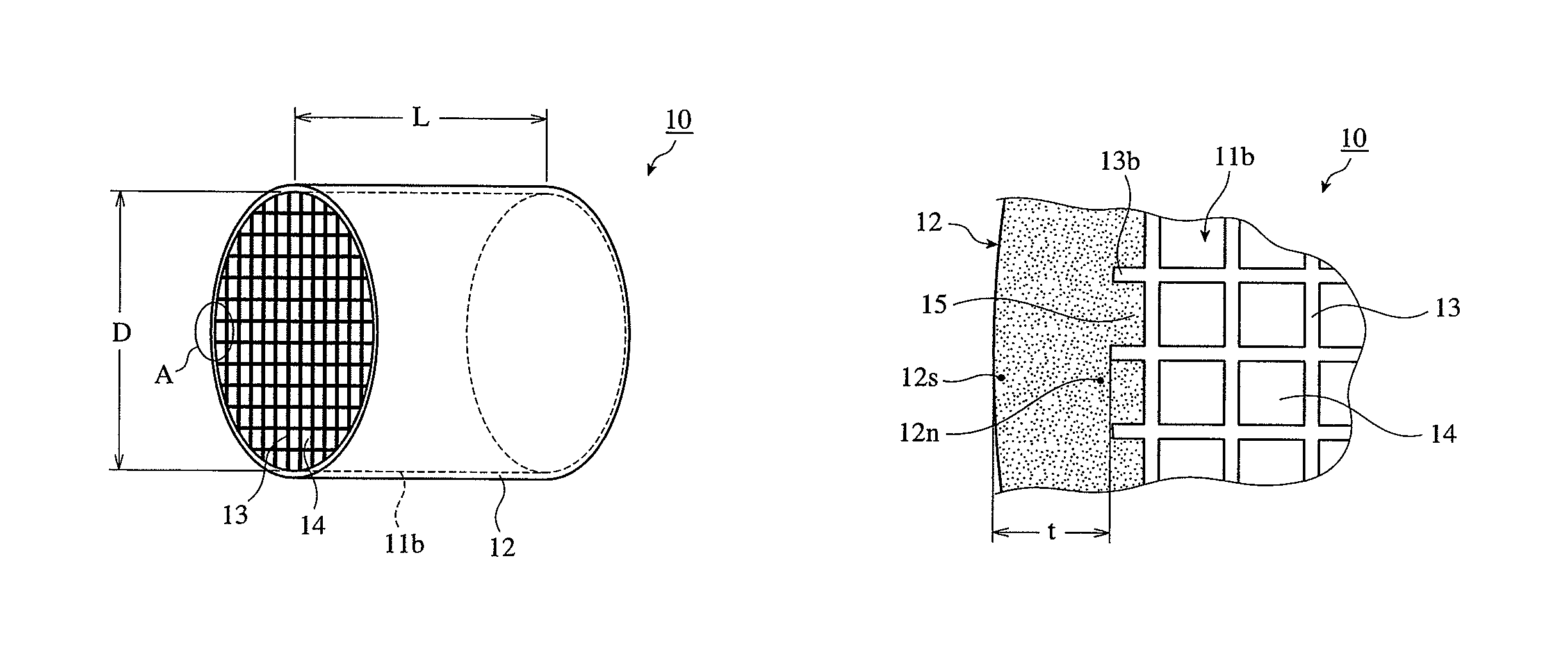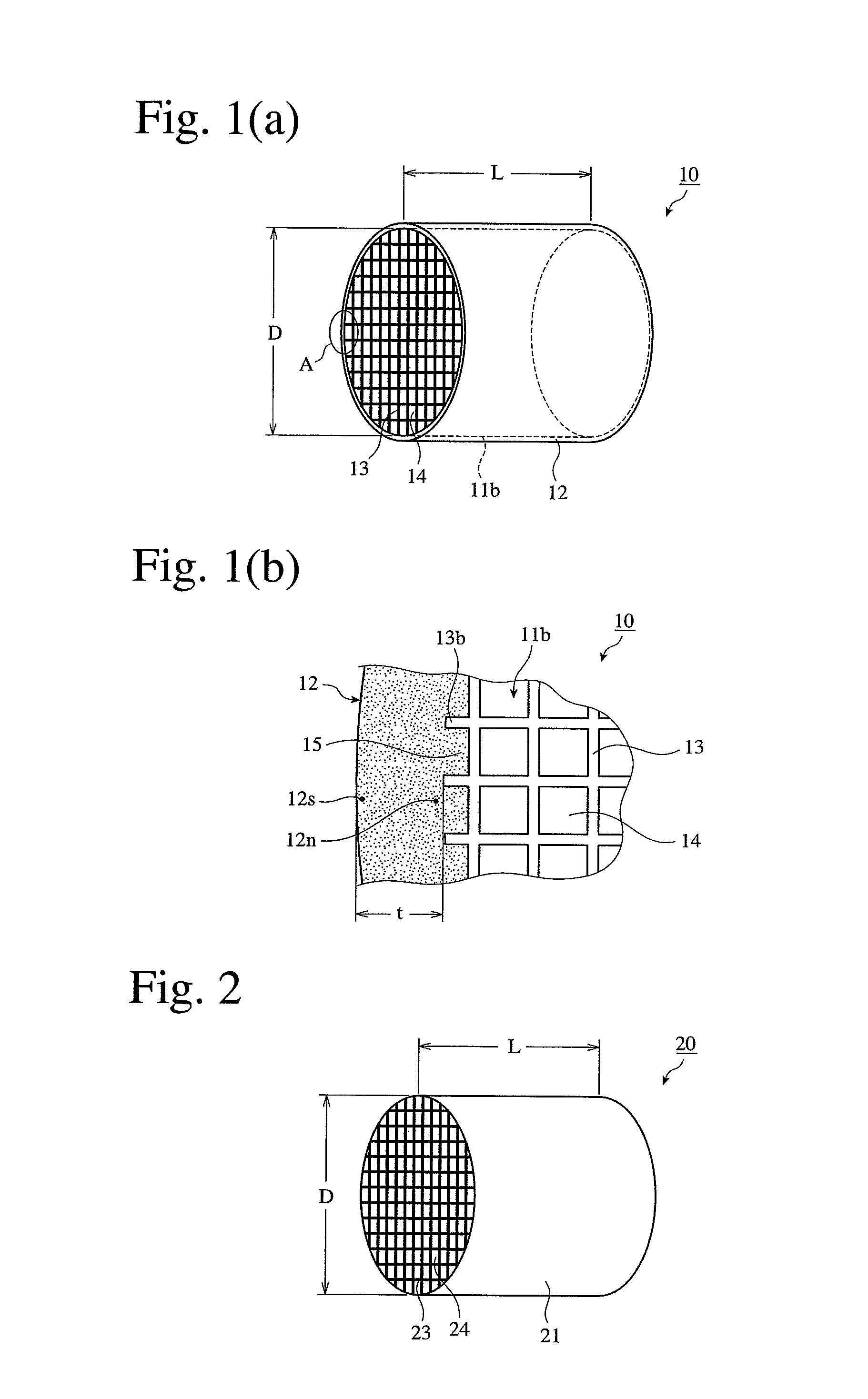Ceramic honeycomb structure and its production method
a honeycomb and honeycomb technology, applied in the direction of metal/metal-oxide/metal-hydroxide catalysts, machines/engines, chemical/physical processes, etc., can solve the problems of low heat shock resistance, less relaxation of the application of the cell wall, and insufficient strength of the honeycomb structure after sintering, etc., to achieve a well-balanced hardness
- Summary
- Abstract
- Description
- Claims
- Application Information
AI Technical Summary
Benefits of technology
Problems solved by technology
Method used
Image
Examples
example 1
[0032]Kaolin powder, talc powder, silica powder and alumina powder were mixed to prepare cordierite-forming material powder comprising 50% by mass of SiO2, 35% by mass of Al2O3 and 13% by mass of MgO. This powder was mixed with methylcellulose and hydroxypropyl methylcellulose as binders, a lubricant, and graphite as a pore former. After thorough dry-blending, water was added to carry out sufficient kneading to prepare a moldable ceramic material.
[0033]This moldable material was extrusion-molded, and cut to a predetermined length to obtain a honeycomb molding integrally having a peripheral wall portion and cell walls. This molding was dried and sintered to obtain a sintered cordierite honeycomb having an outer diameter D of 280 mm, a length L of 300 mm, a cell wall thickness of 0.3 mm and a cell pitch of 1.5 mm as shown in FIG. 1. Using a cylindrical grinding machine, the outermost cell walls 13 were removed from this sintered honeycomb to provide a ceramic honeycomb body 11b with l...
examples 2-11
, CONVENTIONAL EXAMPLES 1 AND 2, AND COMPARATIVE EXAMPLES 1 AND 2
[0034]Ceramic honeycomb structures were produced in the same manner as in Example 1, except for changing the type of ceramic particles in the coating agent for forming an outer peripheral wall, the average particle size and amount of colloidal silica in the coating agent, blending pressure and drying conditions as shown in Table 1. Conventional Example 1 used the coating material described in JP 2004-75524 A, and Conventional Example 2 formed a dense surface layer using the coating material described in JP 2006-255542 A.
[0035]
TABLE 1Colloidal SilicaAverageBlendingCoated CeramicParticleAmount(1)Pressure(2)DryingNo.ParticlesSize (nm)(%)(kPa)ConditionsExample 1Cordierite420Atmospheric150° C., and 10PressureminutesExample 2Cordierite420−80150° C., and 10minutesExample 3Cordierite1020−80150° C., and 10minutesExample 4Cordierite2520−80150° C., and 10minutesExample 5Cordierite3020−80150° C., and 10minutesExample 6Cordierite50...
PUM
| Property | Measurement | Unit |
|---|---|---|
| thickness | aaaaa | aaaaa |
| particle size | aaaaa | aaaaa |
| heat shock resistant temperature | aaaaa | aaaaa |
Abstract
Description
Claims
Application Information
 Login to View More
Login to View More - R&D
- Intellectual Property
- Life Sciences
- Materials
- Tech Scout
- Unparalleled Data Quality
- Higher Quality Content
- 60% Fewer Hallucinations
Browse by: Latest US Patents, China's latest patents, Technical Efficacy Thesaurus, Application Domain, Technology Topic, Popular Technical Reports.
© 2025 PatSnap. All rights reserved.Legal|Privacy policy|Modern Slavery Act Transparency Statement|Sitemap|About US| Contact US: help@patsnap.com


